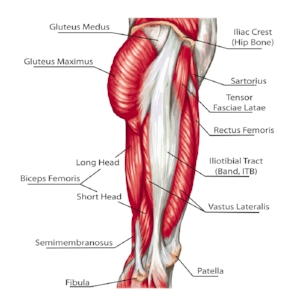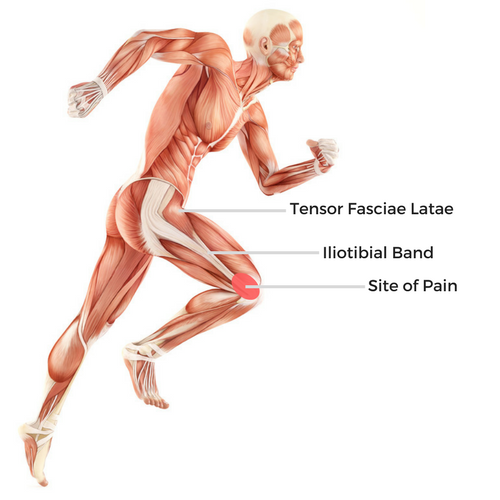I can remember like it was yesterday. I was nearly halfway through Chiropractic school and roughly 1.5 years returned to frequent running. It was a cold morning race, cold enough to earn its race title of ‘Frostbite’ series. As I ran down a slight decline, 3 miles into a 10k jaunt, I felt this sudden STABBING on the side of my right knee. Unsure of what was happening, I was able to run another 400 meters before having to stop and walk...I had never done that before, stopping in a road race was absurd...but to my surprise, outside of a little tightness, the knee pain subsided, that is until I started running again. Within 100 meters, the stabbing pain was back. From there, I journeyed on my longest 10k race to date!
Of all the running injuries that come through the clinic, Iliotibial (IT) Band complaints take the cake. While few runner’s escape the stabbing grip that is an IT Band Syndrome injury, there is much confusion as to what is actually causing the pain, and even more about how to treat it. Nowadays, I encounter a handful of people every week who complain of this exact same thing, so let's take a simple look at what is going on as well as a few proven ways to take care of it.
5 THINGS YOU NEED TO KNOW ABOUT IT BAND SYNDROME
1. It is one of the most frustrating running injuries know to wo/man!
ITBS is a common overuse running injury. The IT band (who wrongly gets most of the attention) is a dense band, made of fibrous connective tissue, that connects the hip to the lower leg, while also crossing the lateral (outside) of the knee, providing stability in the process. The band is a continuation of the Tensor Fasciae Latae (TFL) muscle, acted on by the glute max, and assists in hip extension, abduction, and external rotation.
2. If you succeed in 'stretching' the band...it's called tearing! You Can't Stretch It!
Yes, you read that right, you can’t actually stretch the IT Band. Why? It’s a tendon! It’s Thick! Connective tissue is very strong….the band is like a truck tire! A few studies have attempted to measure some sort of stretch of the band itself, one going as far to harvest the band from cadavers, try to break it down by freezing and thawing the tendon and then put it under mechanical stretch to find that...NOPE, didn’t gain much more than a millimeter. If this is the case, how can you expect it to stretch by rolling the outside of your leg with a piece of foam, or by crossing one leg over the other and leaning into a wall?
3. Running causes this pain, how? Good question...It Depends!
The IT Band is tightest at 30-40 degrees of knee flexion, an angle many runners pass through multiple times in the gait cycle. In addition to this, it can help absorb ground reactive forces from each foot strike while also being required to provide more and more support of the lateral knee as the hip fatigues in the later stages of a run. This allows the hip to drop during the stance phase, causing a valgus knee, excessive foot pronation and pronation speed control, and rotation and friction at the lateral knee. Now, this is all just mechanical mumbo-jumbo. Running irritates it because it is a high friction, high load spot of the lower extremity, and with movement and need for stability and function comes the opportunity for dysfunction. If you combine this with the capacity every runner has to overtrain, or that most new runners take up the sport with no coaching, we have created the perfect storm!
4. But it hurts RIGHT HERE! You mean that is NOT the cause?
We now know that the IT band courses from the outside of the hip/thigh region to the outside of the leg just below the knee, therefore the pain in on the outside of the knee. We bring this up as it is often confused with Runner’s Knee. While both interrupt our ability to enjoy running and racing, they have very different causes and presentations.
5. Treatment is relatively simple, sometimes aggressive, but simple. The commitment, on the other hand...runner's don't do well with commitment.
So where do we focus our attention as we work to decrease the pain and get back to running? THE HIPS! Have you been listening? With runners, there is always a hip component of the problem, in the instance of IT Band complaints, it is a 95% hip problem. As we address how you can begin tackling this irritation on your own, remember that the sight of pain is not always...more like ‘rarely’....the site of the problem.
3 THINGS YOU CAN DO TO TREAT ITBS - A STARTING POINT
Self Treatment Phase 1: Foam Roll and Stretch The Cause
This should be expected, I love the foam roller. Mostly because it is simple to use and travels well, but when used correctly, it is honestly the best $20 you can spend. You are more than welcome to roll over the IT band itself, under 3 circumstances - 1. Know that it will hurt! 2. You admit you are not lengthening the IT band itself and are more addressing trigger points and just smashing the lateral quad into the femur. 3. As with any area, you do not to do it excessively.
With that being said, we DO want to use the foam roller on the posterior hip to address the glutes and external rotators of the hip as well as the TFL muscle itself. Work through these videos, they are no more difficult than sitting on the roller and moving back and forth but I do suggest 3-5 sessions per day, no more than 10-25 rolls up and down on each area of the hip and leg
Self Treatment Phase 2: Strengthen The Hips
Once you have addressed the mobility of the hips and the flexibility of the associated muscles, it’s time to build strength. As we fatigue during running, our hips begin to dip and get sloppy. This not only causes us to be extremely inefficient, but it leads to mechanical breakdown and resulting IT band syndrome related lateral knee pain.
We have worked hard over the last few years to develop a warm-up routine that addresses many of the most common running injuries, and this particular injury is the one that started it all. Our suggestions here is to utilize strength bands in your warm up to ignite the posterior hip, as seen in our BANDS warm-up video. Start with 1 set of 10 for each exercise, PRIOR to running! Exercises: Clams, Bridges, Band Walks.
Self Treatment Phase 3: Increase Cadence/Change the Terrain/Work The Hills
Lastly, while we have little data on how ground reactive forces contribute to IT band complaints, clinically it is a big enough factor for us to consider a few modifications while you run back to health. From personal experience and talking with 1000’s of runners who have worked through their IT band problem in our office, the two things your IT band does not like is hard pavement, and downhill. If you are a runner in Utah, this just set off a huge signal in your brain recalling every race you have ran in the last 2 years and realized they were ALL downhill road races!
Rarely do we shut runner’s down while we are working through an IT band issue but I will suggest 3 ways to change up your running.
Increase your cadence by 10-20 step per minute. While difficult at first, it helps relieve many common running complaints.
Check out some alternate terrain. In my book, it goes trails first, track is a close second, and lastly, the road. I get that it is easiest to run out the door and do a road run but the track (rubber) and especially the trails are much more forgiving to your legs.
Work the hills - YES, UP! Not only is there lest pounding go up a hill, it builds some great strength in the legs and hips!
Work on adding these simple steps into your running warm-up and cool down. One thing I can attest to as a past ITBS sufferer, if you think that once the pain is gone, you can slack on your flexibility, your warm-up, strength training, post-run rolling session...you will be sorely mistaken
Dr. Reheisse is a Board Certified Chiropractic Sports Physician practicing in Cottonwood Heights Utah. Revive Sport & Spine provides evidence-supported chiropractic care and conservative sports injury management.




